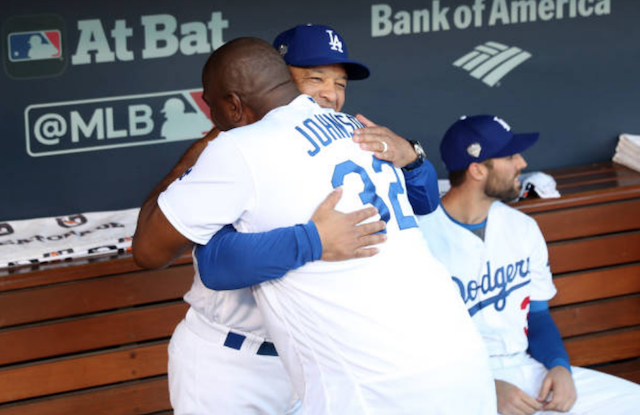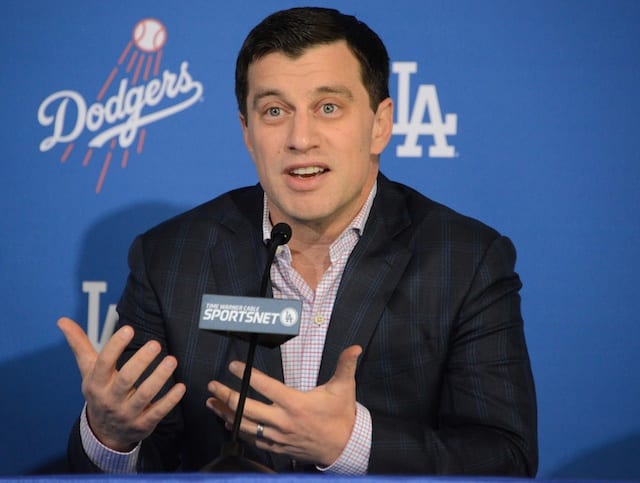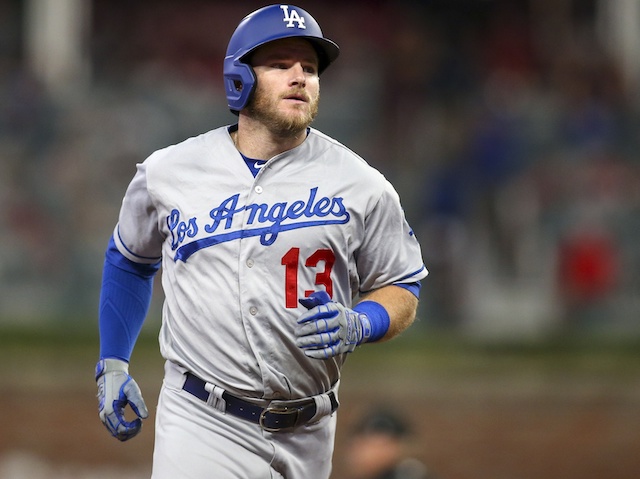This is part one of a two-part recap of some notable Los Angeles Dodgers prospects and their 2019 seasons, plus a look at where they should be this year. We begin with the pitchers, going in alphabetical order, and with the league keys below.
Dominican Summer League (DSL), Arizona League (AZL), Rookie Ogden (RK), Low-A Great Lakes (A), High-A Rancho Cucamonga (A+), Double-A Tulsa (AA), Triple-A Oklahoma City (AAA), Dodgers (MLB)
Yadier Alvarez: (AA) 3.2 IP, 14.73 ERA, 7.00 FIP, 14.7 K/9, 9.8 BB/9
It was another lost year for Alvarez, who has still never thrown more than 93 innings in any of his four professional seasons. Alvarez reached Double-A in 2017, and hasn’t since, and he was placed on the restricted list due to disciplinary violations at the end of last season.
At this point, it is unclear whether Alvarez will ever throw another pitch for a Dodgers’ affiliate, let alone at the Major League level. He possesses otherworldly arm talent, but makeup and character issues have consistently prevented him from realizing his tantalizing potential.
Heisell Baro: (DSL) 44.1 IP, 1.22 ERA, 3.75 FIP, 9.5 K/9, 3.3 BB/9
Baro was one of last year’s surprises, as he was one of the best pitchers in the Dominican Summer League as a 17 year old this year, which ended with him being named to the DSL end-of-the-year All-Star team by Baseball America.
Baro is from a pitching-rich area of Cuba, though little is known about him from a scouting perspective. He’ll very likely start this year in the AZL, where we can get some better looks at him, but so far, he looks like a nice find by the international scouting team.
Gerardo Carrillo: (A+) 86 IP, 5.44 ERA, 4.49 FIP, 9 K/9, 5.3 BB/9
Carrillo didn’t start off well, but he pitched much better after his return from a three-week IL stint in early July. From July 11th on, he threw 37.1 innings of 3.86 ERA/3.34 FIP ball with 41/7 K/BB. This stretch doesn’t even include his seven-inning, two-run playoff start, or his impressive 2.22 ERA in 24.1 innings in the Arizona Fall League, where he reportedly touched 100 MPH.
Carrillo will start this year in Double-A, and will be eligible for the Rule 5 Draft come the winter.
Hyun-il Choi: (AZL) 65 IP, 2.63 ERA, 4.16 FIP, 9.8 K/9, 1.5 BB/9
Choi was one of the breakout pitchers in the system, displaying a five pitch mix as a teenager in the AZL, with a fastball working up to the mid-90s. Choi doesn’t have much physical projection left, but he’s shown good pitchability and could be a nice back-end starter in a few years. Expect him pitching in Great Lakes this season.
Morgan Cooper: (N/A) Did not pitch
Cooper, the Dodgers’ 2017 second-rounder, has yet to throw a professional pitch. Shoulder problems have hampered the former Texas Longhorn, and he recently turned 25, only several months younger than Walker Buehler.
Cooper has the stuff and poise to be a quick mover if he can ever get healthy, the big question is just whether he can.
Leo Crawford: (A+) 91.1 IP, 2.96 ERA, 3.27 FIP, 10.4 K/9, 1.9 BB/9; (AA) 30.1 IP, 2.37 ERA, 3.35 FIP, 8.3 K/9, 2.1 BB/9
Crawford exemplifies the archetypal crafty lefty, who doesn’t throw very hard but fools hitters with deception and precise location. Crawford’s changeup is his best pitch, and it’s the only above average one he has as well.
Unless he can add velocity and/or another reliable pitch, as well as he’s pitched, it’s difficult to see any type of major league future for him that isn’t in a relief role.
Braydon Fisher: (N/A) Did not pitch
The Dodgers’ 2018 fourth-rounder had Tommy John surgery and won’t be expected to pitch until sometime midway this summer. He’ll likely head back to the AZL, where he pitched last year, and potentially some short stints in Great Lakes if all goes well.
Given his youth, the Dodgers will likely handle him carefully, with the reigns staying on well into the 2021 season.
Tony Gonsolin: (AAA) 41.1 IP, 4.35 ERA, 4.38 FIP, 10.9 K/9, 4.6 BB/9; (MLB) 40 IP, 2.93 ERA, 3.86 FIP, 8.3 K/9, 3.4 BB/9
The 2018 Dodgers Minor League Pitcher of the Year continued his positive momentum into 2019, making his MLB debut and performing well filling in for injured starters. While Gonsolin nearly exceeded his prospect status, he’ll probably do so at some point early this year.
And his prior experience in relief makes him a decent bet to make a future playoff roster, even if he’s not one of the four starters.
Victor Gonzalez: (A+) 27.1 IP, 1.65 ERA, 2.57 FIP, 11.9 K/9, 4.6 BB/9; (AA) 48.1 IP, 2.23 ERA, 3.70 FIP, 8.2 K/9, 2.6 BB/9; (AAA) 14 IP, 3.86 ERA, 5.58 FIP, 8.4 K/9, 2.6 BB/9
Gonzalez could once commonly be found among the Dodgers’ top 30 prospects, but injuries forced him to miss nearly two seasons, and his return in late 2018 didn’t inspire much hope. But, he pitched well enough in Rancho in early 2019 to get promoted to Tulsa, where he was shifted to relief, and he excelled.
Gonzalez soon found his way to OKC with another promotion, and was name dropped by Dodgers president of baseball operations Andrew Friedman as a possible postseason bullpen option. The Dodgers added Gonzalez to the 40-man roster to protect him from last December’s Rule 5 Draft, and he could play a role in the Major League bullpen this year.
Josiah Gray: (A) 23.1 IP, 1.93 ERA, 2.25 FIP, 10.0 K/9, 2.7 BB/9; (A+) 67.1 IP, 2.14 ERA, 2.58 FIP, 10.7 K/9, 1.7 BB/9; (AA) 29.1 IP, 2.75 ERA, 2.43 FIP, 9.4 K/9, 2.5 BB/9
One of the two prospects the Dodgers acquired last winter for Yasiel Puig, Matt Kemp, Alex Wood and Kyle Farmer, became one of the best prospects in the organization, rocketing up the Minor League ladder and prospect lists in the process.
Gray, only a full-time pitcher since 2017, displayed two plus pitches (fastball and slider), better than expected command, an ability to limit hard contact, and a developing third pitch in his changeup. His athleticism gives him a high ceiling, and his newness to pitching leaves even more room to dream. Gray could make a major league impact as soon as this upcoming season.
Michael Grove: (A+) 51.2 IP, 6.10 ERA, 3.76 FIP, 12.7 K/9, 3.3 BB/9
The Dodgers drafted Grove with their second round pick in 2018 despite him not pitching since spring 2017 due to Tommy John surgery, and when J.T. Ginn didn’t sign, Grove became the team’s top pick.
Grove’s peripheral numbers were good, but he struggled at times with his command in his first year returning from the surgery, and the Dodgers kept him on a tight leash. He’ll see time in Double-A this season with looser restrictions.
Osvanni Gutierrez: (DSL) 32.1 IP, 3.06 ERA, 3.60 FIP, 8.4 K/9, 2.5 BB/9
Gutierrez was one of four international free agents to receive at least $500,000 from the Dodgers last year, and one of two on the pitching side. The hard-throwing Cuban pitched well in his professional debut, before missing the last few weeks of the year with either an undisclosed injury or just general workload management.
Expect to see him in the AZL sometime this season, if he’s healthy.
Andre Jackson: (A) 48.1 IP, 2.23 ERA, 2.83 FIP, 9.3 K/9, 3.5 BB/9; (A+) 66.1 IP, 3.66 ERA, 3.89 FIP, 12.4 K/9, 5.2 BB/9
Jackson, yet another Tommy John survivor, had a nice little breakout last year, with the reigns getting loosened a bit after being on tighter restrictions last year. Jackson has good size and length, and can get up into the high-90s, but at times struggled with walks, as his results indicate. A return to Rancho may be in his future for 2020, but he might not be there for long.
Marshall Kasowski: (AA) 29.1 IP, 2.45 ERA, 2.50 FIP, 14.1 K/9, 4.9 BB/9
The Dodgers’ 13th round pick from 2017 has probably become their best relief-only prospect. After ascending two levels in 2018, Kasowski was hampered by injuries last year, spending two full months on the IL.
He was effective when healthy, striking out a ton and walking a ton of guys as well. His fastball, though it isn’t premium velocity, really deceives hitters, and he throws it a majority of the time. If he can stay healthy this year, Kasowski should see his first taste of Triple-A, with a chance at the big leagues if he excels.
Jimmy Lewis: Did not pitch
Last year’s second-round pick didn’t see any action, due to a shoulder injured that was reportedly known to teams before the draft. Lewis is expected to be ready for Spring Training. The former LSU commit will likely draw comparisons to Dustin May, for his height (6’5”) and home state (Texas).
Hopefully, Lewis can remain healthy, seeing some time in the short season leagues before moving up to A-ball at some point this season.
Jack Little: (AZL) 3 IP, 0.00 ERA, 1.60 FIP, 12.0 K/9, 0 BB/9; (A) 19 IP, 3.79 ERA, 6.08 FIP, 8.1 K/9, 6.6 BB/9
Another 2019 draftee, Little was an All-American closer in college at Stanford, but the Dodgers look to try him out at a starter first as a pro. Little has the pitch mix and build to work as a starter, though he might end up a reliever anyways.
Though he started off well, he allowed eight earned runs and eleven walks in his final 7.1 innings, altering his small-sample-size totals. Little could begin this year either back at Great Lakes or in Rancho, likely starting again, until he proves he cannot.
Dustin May: (AA) 79.1 IP, 3.74 ERA, 3.12 FIP, 9.8 K/9, 2.3 BB/9; (AAA) 27.1 IP, 2.30 ERA, 3.58 FIP, 7.9 K/9, 2.9 BB/9; (MLB) 34.2 IP, 3.63 ERA, 2.90 FIP, 8.3 K/9, 1.3 BB/9
What a magical year it was for the Dodgers’ top pitching prospect, culminating with an appearance on the postseason roster in October. May was fantastic at all three levels he pitched in last year.
His breaking ball and changeup could use some more development, but he just turned 22, and his two-seamer/cutter combo is already lethal. He’ll be a stalwart in the Dodgers’ rotation for years to come.
Robinson Ortiz: (A) 86.1 IP, 4.59 ERA, 4.80 FIP, 7.7 K/9, 4.2 BB/9
Ortiz pitched the entire year at Low-A as a 19 year old, and he got better as the year went on, with a 3.61 ERA and .224 batting average against after the Midwest League All-Star break. In his last three starts, he allowed just nine hits and two earned runs over 20 innings.
He’s mostly maxed out physically, but he’s displayed a solid level of pitchability while pitching ahead of the age curve. Look for him in Rancho sometime this year, possibly after a return to Great Lakes.
Ryan Pepiot: (AZL) 5 IP, 0.00 ERA, 3.27 FIP, 18.0 K/9, 7.2 BB/9; (A) 18.1 IP, 2.45 ERA, 2.79 FIP, 10.3 K/9, 4.4 BB/9
Pepiot was one of my favorite college pitchers in the draft, I was delighted to see him fall to the Dodgers in the third round. His changeup was one of the best ones in the draft, and he has a history as a starting pitcher.
The Dodgers were careful with him after a full college season, not letting him pitch even three innings in any of his starts. He’ll likely head to Rancho this season, where we’ll get to see what he can really do untethered from innings restraints.
John Rooney: (A) 54.2 IP, 2.63 ERA, 3.74 FIP, 7.2 K/9, 4.1 BB/9; (A+) 50 IP, 3.06 ERA, 4.24 FIP, 8.1 K/9, 2.5 BB/9
Rooney, a 6’5” lefty, pitched well across two level last season. The former third-rounder is much more of a high floor guy than a high ceiling one, but is arguably the most touted lefty in a system much heavier on righties. He’ll see some time in Rancho again, with another midseason promotion, this time to Tulsa, likely in the cards.
Jerming Rosario: (DSL) 45.1 IP, 0.79 ERA, 2.93 FIP, 8.5 K/9, 2.9 BB/9
Rosario was the team’s top pitching signee on July 2, 2018. He proved why the Dodgers were so high on him in his pro debut, garnering Baseball America’s Dominican Summer League Pitcher of the Year. Rosario allowed just four earned runs in 45.1 innings last season, and will be a player to watch in the AZL this summer.
Dennis Santana: (AAA) 93.1 IP, 6.94 ERA, 5.77 FIP, 10.1 K/9, 5.1 BB/9; (MLB) 5 IP, 7.20 ERA, 7.01 FIP, 10.8 K/9, 7.2 BB/9
After a stellar 2018 which saw Santana rise from Double-A to the Majors, all in the first half of the season, he took a step back last year, following an injury that wiped out the second half of his 2018.
While the juiced balls in Triple-A certainly didn’t help, Santana didn’t look like the same pitcher last year, and was shifted to relief towards the end of the season. Whether that move will be permanent isn’t known yet, but the converted shortstop is another Major-League ready arm who could make an impact for the Dodgers this year.
Josh Sborz: (AAA) 50 IP, 4.68 ERA, 2.44 FIP, 12.2 K/9, 2.5 BB/9; (MLB) 9 IP, 8.00 ERA, 5.88 FIP, 7.0 K/9, 4.0 BB/9
While Sborz’s Major League debut left some to be desired, he had himself a pretty good year down in Triple-A, even with the juiced ball. As you can see from his ERA/FIP, he was a little unlucky allowing runs, but still struck out a ton of guys and kept his walks down.
Sborz pairs his fastball with an over-the-top curveball, and could be a useful middle relief arm as soon as this season, if he can manage to get on the major league roster.
Jordan Sheffield: (A+) 17.1 IP, 2.60 ERA, 4.07 FIP, 13.5 K/9, 5.7 BB/9; (AA) 37.2 IP, 3.58 ERA, 4.65 FIP, 11.5 K/9, 7.7 BB/9
The former first-round pick had his best pro season yet, reaching Double-A for the first time, and excelling at times in his first year as a reliever. His struggles, with his control, were also familiar, and it’s what likely kept him off the Dodgers’ 40-man roster this winter, despite being Rule 5 Draft eligible.
The Dodgers can be thankful he wasn’t selected, and he’ll get another year to refine his command in hopes of being added next offseason. Sheffield has closer-level stuff if he can control it, but that has been a big “if” so far in his career. He might return to Tulsa to start the year, but expect him to get his first taste of Triple-A at some point.
Edwin Uceta: (A+) 50.1 IP, 2.15 ERA, 3.76 FIP, 11.6 K/9, 2.9 BB/9; (AA) 73 IP, 3.21 ERA, 3.78 FIP, 9.4 K/9, 4.1 BB/9
If not for Gray or May, Uceta would have a strong case for the best performance among Dodger pitching prospects in 2019. The diminutive righty saw time across two levels and pitched well at both, moving his stock up quite a bit last year. While he may return to Double-A to begin this season, he doesn’t have much left to prove there.
Mitchell White: (AA) 30 IP, 2.10 ERA, 3.08 FIP, 11.1 K/9, 2.1 BB/9; (AAA) 63.2 IP, 6.50 ERA, 5.49 FIP, 9.6 K/9, 3.4 BB/9
White made his third try in Double-A the charm last season, finally moving up to Triple-A, where he got roughed around some by the more advanced hitters (and juiced ball). The former second-rounder is as enigmatic as any Dodger pitching prospect not named Alvarez.
When healthy, he’s flashed No. 2 or 3 starter stuff, but there have been questions on how healthy he’s truly been over the past couple years. While White no longer holds the lofty prospect status he once did, he should return to Triple-A and could be ready for a call up sometime this season.
Have you subscribed to our YouTube channel? It’s the best way to watch player interviews, exclusive coverage from events, participate in our live shows, and more!








